God, I’ve had to suffer some utterly appalling vehicles in my fifty years of driving a 4WD, especially when it comes to illumination. You know how it goes, a trip is planned, and it’s wedged between work dates and with never nearly enough time available to do the drive justice. Inevitably you’ll be coming back in darkness and if you’re relying on a standard high-beam headlight to light the path it’ll likely be the cause of an animal connection or worse, a massive crash with all the risk that usually brings with it.
The solution back in the day was to add a pair of spotties.

I’ve done that on every bus I’ve owned and the difference is illuminating!
In the 1970s the answer was pretty focussed because there weren’t too many options available. You could dip into some USA imports that owed their existence to Baja Racing but they were mostly crap. The housings couldn’t cop Aussie Outback corrugations and their shells fatigued and broke up and you couldn’t keep them tight, a beam either pointing down on the road in front of you or pointing to the heavens. The more reliable and very expensive alternatives were largely based on the European Rally experience and using lights from the French mob Cibie, the Italians at Carello, Hella in Germany, or the Poms at Lucas (AKA Lucas – Prince of Darkness). I went down the Cibie route and their Oscar and Super Oscar driving lights were without peer and for a long time.

Inevitably though things change and a combination of new light technologies, coupled to new manufacturing methods affecting the cost, saw the availability of a lot of products in Australia disappear because the Pacific Peso wasn’t worth much. Remember, this was before the age of globalism and immediate internet ordering from any corner of the world.
ARB, that Australian 4WD accessory powerhouse, imported IPF lights from Japan through the 1990s and I can remember using a range of their 900 and 600 series lamps on my old Rodeos, Jackaroos and Navaras and at the time thinking they were doing an admirable job… they were, but???

The but is that whilst the road ahead was suddenly a whole lot clearer, it certainly wasn’t turning night into day, nor was it especially a crisper colour, until some bright spark decided to employ LEDs.
In the evolution of automotive lighting we’ve seen halogen and then HID and now LEDs, with brighter and brighter results as each technology has been eclipsed, and that my friends, makes for a much safer night-time drive on those occasions when the sun dips and you’ve still got hours to travel.
There are so many makers of auxiliary automotive lighting these days and that choice is a good thing, along with the array of styles of lights they offer. Traditional spotlights in round or rectangular do the job they’ve always done, offering a penetrating spot beam or a wider spread, whilst light bars can take on just about any role and fill just about any space. In recent times some LEDs have morphed into offering an auxiliary DRL (Daytime Running Light) function to augment that seen on the car as supplied, to meet ADR (Australian Design Rules) standards mandated for new vehicle sales.
I’ve tried a couple of LED variants in recent years and because I do a lot of night-time driving, I can swear on a stack of bibles and tell you that they are one of the greatest safety innovations in recent times and worth every cent. Every cent!

Our previous Isuzu MU-X wore one of ARB’s Intensity Light Bars to incredibly good effect when matched to one of their bullbars, the top loop providing the mounting point for the lamp. The clamping system was very positive, never once coming loose, or vibrating, something critical to good lamp use.

The mounting system will also permit a traditional pedestal mount for a flat surface, or, if you want to install it up under your roof rack, the kit will get you an integrated look that retains all the adjustability needed for light alignment from up above.
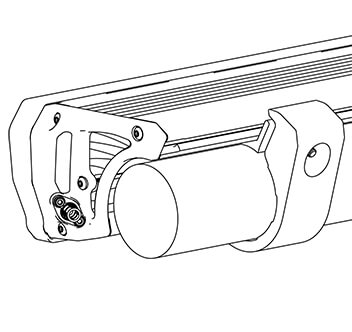
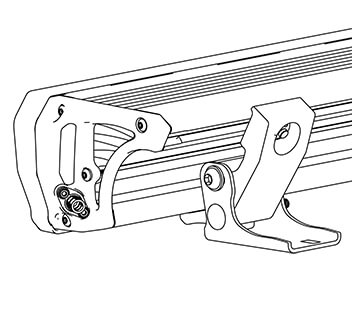
The Intensity Light bar runs 40 OSRAM LEDs in a 2 x 20 configuration stacked atop one another and housed within an aluminium body with a polycarbonate lens and will cop a ton of abuse, abuse ranging from roadside gravels flicked its way, to mud and slop, to errant vegetation (makes me wince when I think about how many times it’s been clobbered).

It’s a tough housing and the light it provides stretches to nearly a kilometre (926m) at 1 LUX (the comparable illumination of a metre-square surface at one metre’s distance from a standard candle (light measure)). That’s pretty impressive and I know it’s saved our bacon on more that one occasion dealing with errant cattle and kangaroos.

The input voltages it will accept range from 9-36V DC and the current draw is 21A at 14.4V and ARB claim an output of 25,080 raw lumens with a colour temperature of 5,700K (Kelvin). Lamp dimensions run 560mm W x 91mm H x 125mm D and it weighs a little over 4 kgs.
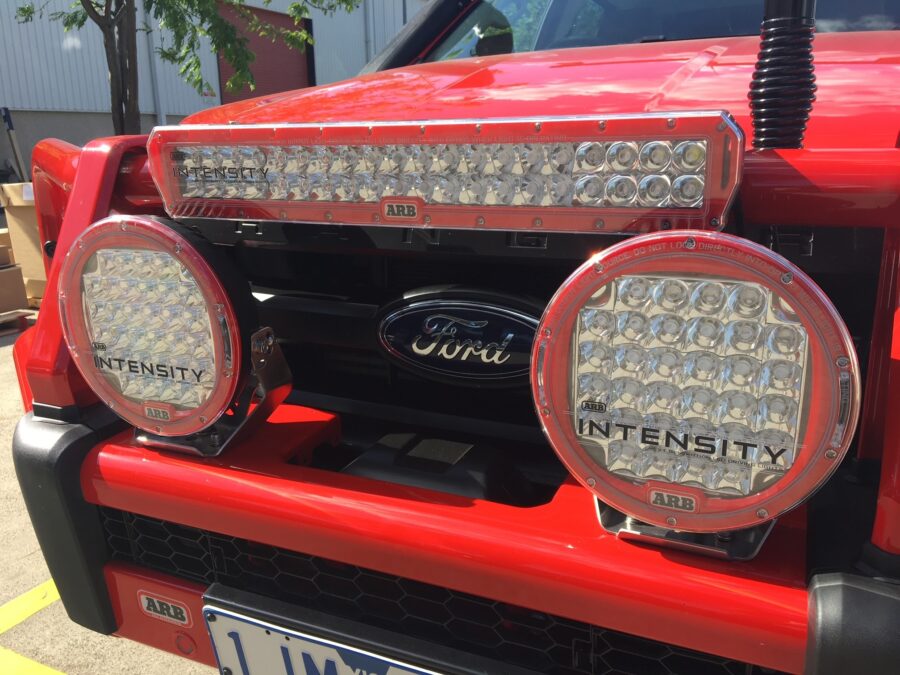
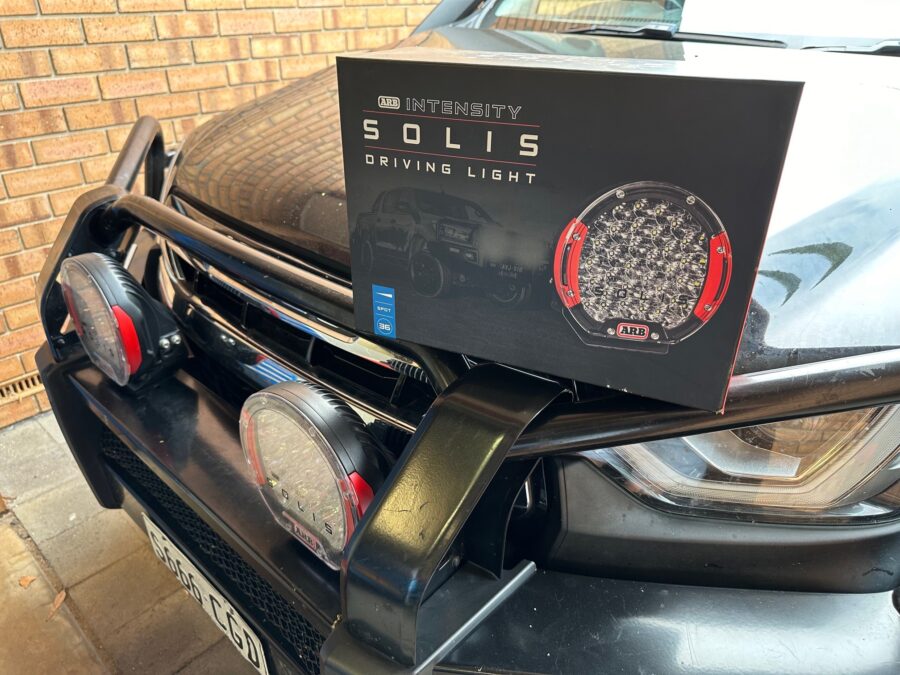
On my new D-MAX I’ve gone down a different path as the vehicle was supplied with a genuine Isuzu steel bullbar and the top loop’s diameter is different to that offered by ARB. In it’s place I opted for ARB’s Solis offering, initially a pair of 9” spotties in a spread and spot beam configuration and mounted pedestal-style on the bumper in front of the grille in the traditional fashion.

The Solis is also available in a 7” option where space might be a bit tight and the difference between the two is that lamp diameter determines how many OSRAMs you can squeeze in, the 9” featuring 36 LEDs and the 7” 21 LEDs.
In either lamp’s case the construction is robust, an aluminium bucket, and again finned for cooling, supports the LED array and its tough polycarbonate lens and for a bit of bling there are a pair of either red or black accent lens-rim pieces that can be swapped in or out depending on your daily feng-shui!

The all-important visibility-at-distance measurements say that the 9” spot beam offers 1 LUX at 1,032m distance whilst the spread beam shows 1 LUX at 729m.
It will accept input voltages from 10-30V with a current draw of 12.4A at 13.2V and ARB claim 9,546 raw lumens for the spot and 8,333 raw lumens for the spread beam and both are rated at 5,700K (Kelvin) colour temperature for a nice natural light. Lamp dimensions are a 225mm diameter x 120mm D and weigh 3.3kgs per lamp.
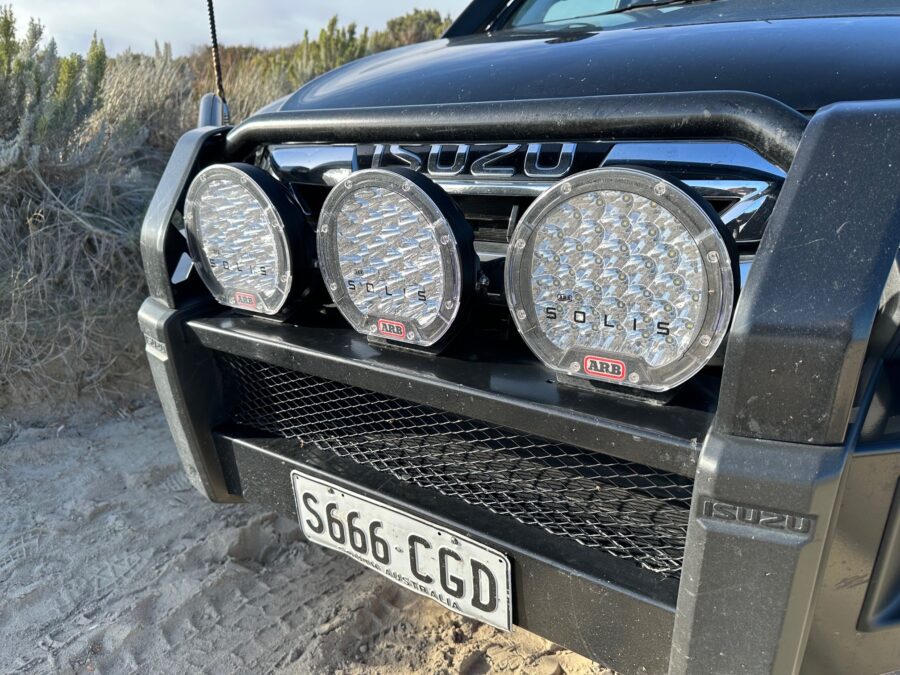
Now, I opted for a trifecta of Solis on the D-MAX, not because the light output wasn’t impressive enough (because trust me it is), but to correct the dismal styling of the vehicle’s bullbar and to smarten its fortunes, and the more the merrier I say!

With a third lamp installed in the centre of the bullbar it meant drilling a couple of holes to accept the mount which was easy to do before sending the car across to my favourite Adelaide auto sparkie for the electrical connection, spliced into the previously supplied (ex-ARB) loom. Easy when you know how and if you decide to go down this path be prepared for an alternator upgrade because the stockie at low engine speeds will struggle to keep the battery happy, OK on the highway, but crawling around might put a dent in your stored amps!

The light from three of these buggers is staggering and luckily the kit came with a dimmer for those moments when you can have too much of a good thing!
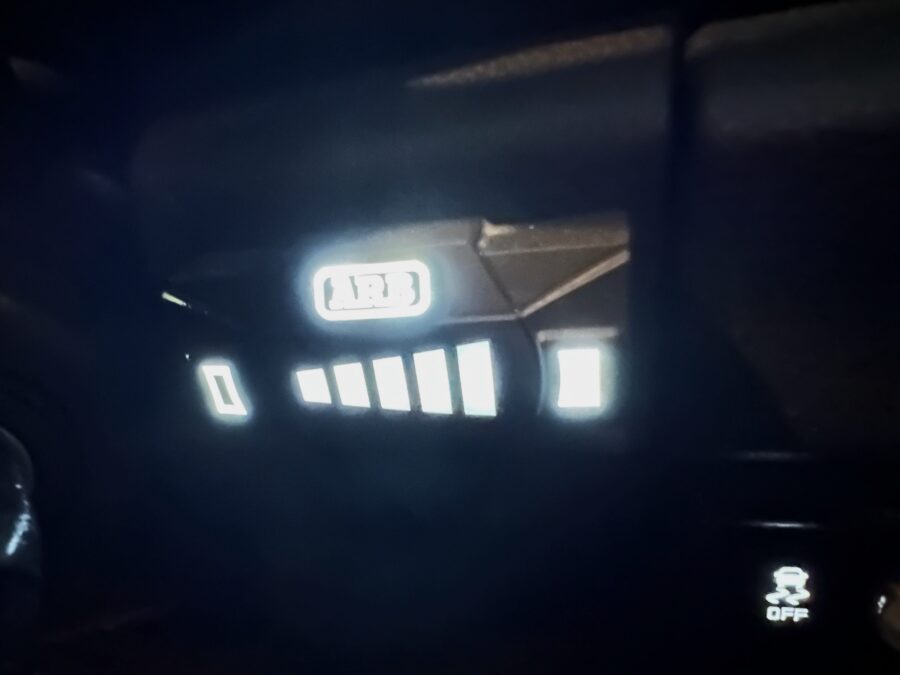
Don’t sweat on the obstruction to the grille’s area in terms of affecting cooling efficiency with the three-lamp setup, as I’ve not noticed any temperature creep, even on a hot 40C Adelaide summer’s day.
I reckon that in terms of best-bang-for-buck when it comes to fitting out a vehicle in readiness for travel you need to follow the same script I’ve been following for the last half-century – suspension, tyres, a fridge and driving lights.

Suspension for a bit of extra clearance and carrying capacity, tyres so you can keep the air in them and carry a load reliably, a decent fridge to celebrate the journey and equally important, added lights so you can see where you are going.
In case you were thinking this was a free plug for ARB’s Intensity lighting range, it isn’t. The object of the article is to encourage you to follow my lead, because if night-time driving is part of your routine, standard headlights are just plain dim and dangerous and nothing will fix them. There are plenty of brands out there with good product. Do your research, look at the reviews and make an informed purchase and I’m sure you’ll revel in your new-found brightness!





GIPHY App Key not set. Please check settings